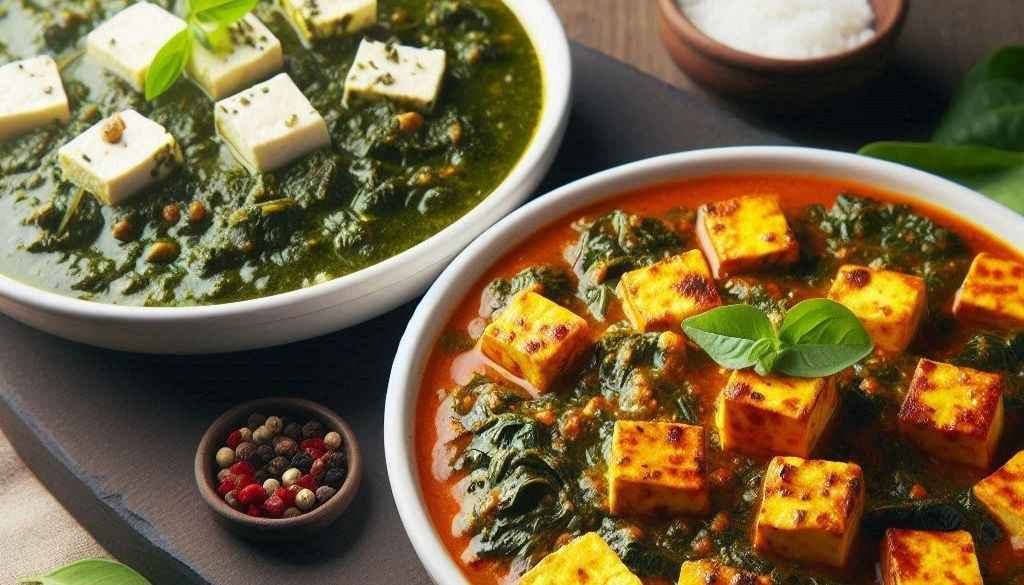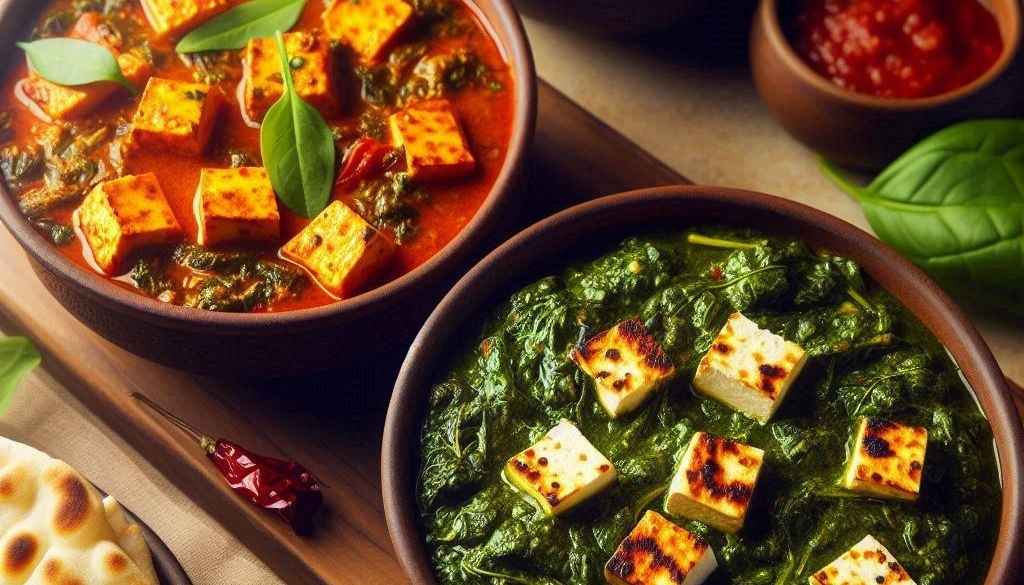Saag Paneer vs Palak Paneer: Indian cuisine is a delightful medley of flavors, spices, and textures. Some of its most loved vegetarian dishes include saag paneer and palak paneer.
While both include the beloved paneer (Indian cottage cheese) and green-based gravy, they are not the same.
Let’s take a deeper look at these two popular dishes to find out what differentiates them and address the main question: Palak Paneer vs Saag Paneer, Which is Better?
What is Saag Paneer?
Saag paneer is a classic North Indian dish in which paneer (Indian cottage cheese) is cooked in a gravy made of mixed leafy greens. The term “saag” refers to a mix of greens, such as sarson ka saag (mustard), methi leaves (fenugreek), palak (spinach), and bathua (goosefoot). Depending on the region and the cook’s preference, the greens can vary, making saag paneer a dish with many interpretations.
This dish is traditionally associated with Punjab and is most loved in winter when fresh vegetables are available in abundance. It is usually served with makki di roti (corn bread), a combination that is not only filling but also iconic in Indian cuisine.
What is Palak Paneer?
Palak paneer, on the other hand, is a simpler variation of saag paneer, focusing specifically on palak (spinach). The dish features soft paneer pieces simmered in a creamy spinach gravy with mild spices. What makes it special is its bright green color, which is achieved by boiling the spinach before pureeing it.
The flavor of palak paneer is less complex than saag paneer as it relies on the unique flavor of spinach. However, its simplicity has helped it gain huge popularity across the world, especially among people new to Indian cuisine. The creamy, mildly spiced gravy makes it a comforting and visually appealing dish.

Main Difference Between Saag Paneer and Palak Paneer
1. Ingredients
- Saag Paneer: Made using garlic, ginger, and spices along with a blend of mustard, fenugreek, spinach, and other greens.
- Palak Paneer: Specifically uses spinach as the base green, with a simple combination of garlic, ginger, and cream.
2. Taste Profile
- Saag Paneer: Offers an earthy, robust flavor with a hint of bitterness, balanced by the spices and butter.
- Palak Paneer: Has a mild, creamy, and slightly sweet flavor, appealing to a wide palate.
3. Cooking Style
- Saag Paneer: Often slow-cooked to allow the flavors of the various greens to meld together.
- Palak Paneer: It is quick to make due to the simplicity of the spinach puree.
4. Texture and Appearance
- Saag Paneer: Usually dark and coarse in texture due to the blend of greens.
- Palak Paneer: Bright green and smooth due to the spinach puree.
5. Nutritional Information
- Saag Paneer: It provides a wide range of nutrients from the various vegetables used.
- Palak Paneer: Spinach is a rich source of iron, calcium, and vitamin A.
Comparison Table: Saag Paneer vs Palak Paneer
| Aspect | Saag Paneer | Palak Paneer |
|---|---|---|
| Main Ingredient | Mix of greens (mustard, fenugreek, spinach, bathua, etc.) | Spinach (palak) only |
| Flavor Profile | Earthy, robust, and slightly bitter | Mild, creamy, and slightly sweet |
| Texture | Coarse and rustic | Smooth and creamy |
| Cooking Style | Slow-cooked for deeper flavor | Quick preparation due to pureed spinach |
| Nutritional Value | Diverse nutrients from multiple greens | High iron and vitamin A content from spinach |
| Cultural Pairing | Traditionally served with makki di roti | Pairs well with naan or jeera rice |
| Color | Dark green | Bright green |
Saag Paneer vs Palak Paneer: Which is better?
This debate comes down to personal preference. If you like complex, earthy flavors and don’t mind a slightly rough texture, saag paneer is the perfect dish for you. On the other hand, if you like a creamy, mildly spicy dish with a tangy appearance, palak paneer might be your go-to dish.
From a nutritional standpoint, saag paneer has a wide range of nutrients, while palak paneer has the concentrated benefits of spinach. Both dishes are versatile, delicious, and healthy, making them great additions to any meal plan.
Nutritional Benefits of Saag Paneer
Saag paneer is a storehouse of nutrients thanks to its variety of vegetables. Mustard greens are very high in vitamin K, which maintains bone health and contains antioxidants that reduce inflammation. Fenugreek leaves provide fiber and promote digestion, while spinach provides iron and folate. This variety makes saag paneer an excellent dish to boost immunity and overall health.
Nutritional Benefits of Palak Paneer
The star of palak paneer is spinach, known for its high iron content, which helps fight anemia. It is also rich in vitamin A, which is important for healthy vision, and magnesium, which supports muscle function. The creamy gravy in palak paneer is often enriched with milk or cream, which adds a dose of calcium to the dish.
Which is healthier, Saag Paneer or Palak Paneer?
It is hard to declare a clear winner here, as both dishes have their own unique nutritional strengths. Saag paneer has a wide variety of nutrients, while palak paneer has a concentrated dose of the health benefits of spinach. Your choice may depend on your dietary needs and taste preferences.

Cooking Techniques: Saag Paneer and Palak Paneer
How to Cook Saag Paneer
- Choose fresh greens: Use a mix of fresh, seasonal greens for the best taste.
- Simmer slowly: Greens need to be cooked on low flame to soften and blend their flavors.
- Spice generously: Whole spices like garlic, ginger, cloves, and cinnamon enhance the flavor of the dish.
- Finish with ghee: A drop of ghee makes the dish rich and enhances the flavor.
How to Make the Best Palak Paneer
- Blanch the spinach: Boil the spinach slightly and cool it in ice water to retain its bright green color.
- Blend smoothly: Puree the spinach to get a creamy texture.
- Add the paneer slowly: Paneer pieces should be added at the end to avoid breaking.
- Keep it mild: Less spices allow the flavor of the spinach to shine through.
Serving and Pairing Suggestions
Best with Saag Paneer
Saag paneer is best enjoyed with makki ki roti, which enhances its earthy flavor. Alternatively, it can be served with naan, tandoori roti, or steamed rice. A dollop of butter or pickles makes it even more delicious.
Best with Palak Paneer
The creamy texture of palak paneer makes it perfect with jeera rice or garlic naan. It can also be served with chapatis for a light meal. For added variety, serve it with spicy daal or tangy dahi raita.
Conclusion
Both saag paneer and palak paneer hold a special place in Indian cuisine. Their unique flavors, textures, and cultural significance make them equally worthy contenders for the title of the best paneer-based dish. Instead of choosing either one, why not enjoy the best of both worlds? After all, both offer a culinary experience that’s hard to beat.
Frequently Asked Questions
-
What makes saag paneer different from palak paneer?
Saag paneer contains a mix of greens, including mustard greens, fenugreek, and spinach, while palak paneer contains only spinach.
This difference in greens gives saag paneer a more robust, earthy flavor and coarse texture, while palak paneer has a mild, creamy flavor and smooth consistency. -
Which dish is more nutritious: saag paneer or palak paneer?
Both dishes are very nutritious but in different ways. Saag paneer contains a variety of vitamins and minerals, while palak paneer contains an excellent source of iron, vitamin A, and calcium from the spinach. Your choice depends on your nutritional needs.
-
Can I make these dishes vegetarian?
Yes, both saag paneer and palak paneer can be made vegetarian. Simply use tofu in place of paneer and use plant-based alternatives like cashew cream or coconut milk in place of dairy cream.
-
Which dish is easier to make for beginners?
Palak paneer is generally easy and quick to cook as it requires fewer ingredients and fewer steps. Saag paneer, which involves green vegetables and a slow cooking process, takes more time and effort to make.
-
What is the best pairing for saag paneer and palak paneer?
Saag paneer goes great with makki ki roti or naan. Its earthy flavor complements the rustic taste of makki roti.
Palak paneer is best enjoyed with soft naan, parathas or jeera rice. Its creamy texture pairs well with these light dishes.


1 thought on “Saag Paneer vs Palak Paneer: Which is Better?”